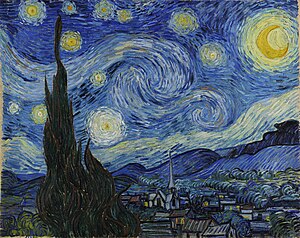
The Starry Night is an oil on canvas by the Dutch post-impressionist painter Vincent van Gogh. Painted in June, 1889, it depicts the view from the east-facing window of his asylum room at Saint-Rémy-de-Provence, just before sunrise, with the addition of an idealized village.[1][2][3] It has been in the permanent collection of the Museum of Modern Art in New York City since 1941, acquired through the Lillie P. Bliss Bequest. It is regarded as among Van Gogh's finest works,[4] and one of the most recognized monuments in the history of Western culture.[5][6]
In the aftermath of the 23 December 1888 breakdown that resulted in the self-mutilation of his left ear,[7][8] Van Gogh voluntarily admitted himself to the Saint-Paul-de-Mausole lunatic asylum on 8 May 1889.[9][10] Housed in a former monastery, Saint-Paul-de-Mausole catered to the wealthy and was less than half full when Van Gogh arrived,[11] allowing him to occupy not only a second-story bedroom but also a ground-floor room for use as a painting studio.[12]
During the year Van Gogh stayed at the asylum, the heavy output of paintings he had begun in Arles continued.[13] During this period, he produced some of the best-known works of his career, including the Irises from May, 1889, now in the J. Paul Getty Museum, and the blue self-portrait from September, 1889, in the Musée d'Orsay. The Starry Night was painted mid-June by around 18 June, the date he wrote his brother Theo to say he had a new study of a starry sky.[14][1][15][L 1]
Although The Starry Night was painted during the day in Van Gogh's ground-floor studio, it would be inaccurate to state that the picture was painted from memory. The view has been identified as the one from his bedroom window, facing east,[2][16][1][17] a view which Van Gogh painted variations of no fewer than twenty-one times,[citation needed] includingThe Starry Night. "Through the iron-barred window," he wrote to his brother, Theo, around 23 May 1889, "I can see an enclosed square of wheat . . . above which, in the morning, I watch the sun rise in all its glory."[2][L 2]
Van Gogh depicted the view at different times of day and under various weather conditions, including sunrise, moonrise, sunshine-filled days, overcast days, windy days, and one day with rain. The hospital staff did not allow Van Gogh to paint in his bedroom, but he was able to make sketches in ink or charcoal on paper, and eventually he would base newer variations on previous versions. The pictorial element uniting all of these paintings is the diagonal line coming in from the right depicting the low rolling hills of the Alpillesmountains. In fifteen of the twenty-one versions, cypress trees are visible beyond the far wall enclosing the wheat field. Van Gogh telescoped the view in six of these paintings, most notably in F717 Wheat Field with Cypresses and The Starry Night, bringing the trees closer to the picture plane.[citation needed]
The Starry Night is the only nocturne in the series of views from his bedroom window. In early June, Vincent wrote to Theo, "This morning I saw the countryside from my window a long time before sunrise with nothing but the morning star, which looked very big"[L 5] Researchers have determined that Venus was indeed visible at dawn in Provence in the spring of 1889 and at that time was near its brightest possible. So the brightest "star" in the painting, just to the viewer's right of the cypress tree, is actually Venus.[20][22]
The moon is stylized, as astronomical records indicate that the moon was waning gibbous at the time Van Gogh painted the picture.[20] Even if the phase of the moon had been a waning crescent at the time, Van Gogh's moon is not astronomically correct. (For other interpretations of the moon, see below.) The one pictorial element that was definitely not visible from Van Gogh's cell is the village,[23] which is based on a sketch F1541v made from a hillside above the village of Saint-Rémy.[3] Pickvance thought F1541v was done later and the steeple more Dutch than Provcençal, a conflation of several Van Gogh had painted and drawn in his Nuenen period, and thus the first of his " reminisces of the North" he was to paint and draw early the following year.[1] Hulsker thought a landscape on the reverse F1541r was also a study for the painting.[24]
1889年,在与高更一次争吵之后,梵高精神分裂症复发而割下了自己的左耳,并用手帕包起后送与一名妓女。之后于5月8日自愿前往阿尔勒圣雷米的一家精神病院治疗,在那驻留了108天。在入住精神病院期间,梵高创作了大量的绘画作品,共计一百五十多幅油画和一百多幅素描。在此阶段的绘画,梵高的画风开始趋向于表现主义,作品充满忧郁精神和悲剧性幻觉,其中作品《星夜》正是其中代表之一。[1]而作品《星夜》是在医生允许梵高白天可以外出的条件下所创作,而其作品所描述的风景也正是精神病院所在地圣雷米。 [2]
作為表現性的後印象主義畫家梵高的作品,這幅畫有很強的筆觸。油画中的主色调藍色代表不開心、陰沉的感覺。很粗的筆觸代表憂愁。畫中景象是一個望出窗外的景象。畫中的樹是柏樹,但畫得像黑色火舌一般,直上云端,令人有不安之感。天空的紋理像渦狀星系,并伴随众多星点,而月亮则是以昏黄的月蚀形式出现。整幅画中,底部的村落是以平直、粗短的线条绘画,表现出一种宁静;但与上部粗犷弯曲的线条却产生强烈的对比,在这种高度夸张变形和强烈视觉对比中体现出了画家躁动不安的情感和迷幻的意象世界。[1]梵谷生前非常欣賞日本浮世繪《冨嶽三十六景》中的《神奈川沖浪裏》,而《星夜》中天空的涡状星云画风被認為參考並融入了《神奈川沖浪裏》的元素。
No comments:
Post a Comment